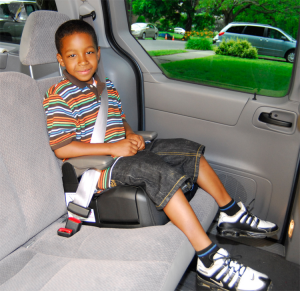
Did you know many children are moved out of their booster seats too soon? Even though they are excited to hit the next milestones, rushing to move out of the booster seat will compromise the safety of the child unless they are truly ready.
The American Academy of Pediatrics recommends all children whose height or weight is above the forward-facing limit for their child passenger safety seat should use a belt-positioning booster seat until the vehicle lap and shoulder belt fits properly, typically when they have reached 4 ft 9 inches in height and are between 8 and 12 years of age. For reference, The Tennessee Child Restraint Law requires a child to be 9 years old and 4 ft 9 inches tall before getting out of a booster seat.
According to Consumer Reports, you can use this simple 5 step checklist to help know for sure if your child is ready to move out of the booster. If your answer to any of these questions is no, the safest option for your child is to remain in their seat until the answer to all 5 questions is a confident yes.
1) Is the child’s back flat against the back of the vehicle’s seat?
· The child’s back needs to be flat against the vehicle seat back.
· If their back is not against the seat, they may slide their hips forward creating a gap between the seat and their back which will in turn cause the lap belt to ride up onto their belly increasing risks of internal organ damage.
2) Do the child’s knees bend at end of the seat’s edge?
· The child’s knees should bend comfortably at the seat edge.
· Most children slouch so their knees can comfortably bend, but this forces the seat belt up from their hip bones and on to their belly.
3) Is the shoulder belt centered between the child’s neck and shoulder?
· The seat belt should be positioned in between the child’s neck and shoulder.
· If the shoulder belt sits too close to the neck, it can injure a child’s neck and throat. The discomfort of the belt at the neck tempts them to move it behind their back for more comfort. If the shoulder belt sits off the child’s shoulder, it is likely to slip off during a crash, and it will not protect the child as it was intended to in a crash.
4) Does the lap belt sit low across the top of the thighs?
· The lap belt should sit low across the top of the child’s thighs across the hip bones.
· If the lap belt portion of the seat belt is across the soft belly, it increases the potential for damage to the child’s internal organs in a crash.
5) Can the child remain seated comfortably for the whole trip?
· Is the child is mature enough to sit properly in the booster for the entire trip (no slouching, no leaning over, no messing with the seat belt).
· The child should be able to stay comfortably seated for the entire trip.
Remember, even when a child can pass the 5-step seat belt fit test based on the child’s height, this can differ greatly from car to car. They may be able to pass the 5-step test in one car and not in another. Or even in one seating position in a car, but not another. Usually by the time they are 4’9” (or 57”) they can fit properly in most vehicle’s seat belts.
To learn more about car seat safety and other topics please subscribe to our FREE newsletter below.